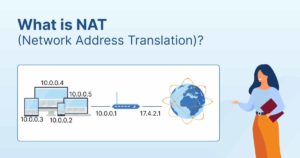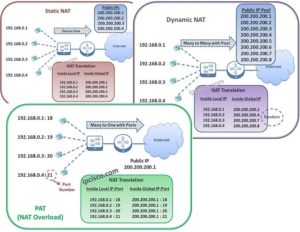
Table of Contents
1. Introduction to Network Address Translation (NAT)
Network Address Translation (NAT) is a widely used process in modern networking that allows devices on a private network to share a single public IP address for accessing the internet. NAT plays a crucial role in conserving IPv4 addresses, enhancing network security, and enabling multiple devices to connect to the internet seamlessly. If you’ve ever wondered how so many devices in your home or business can share the same internet connection, NAT is the key to making it happen.
Given the limited supply of public IPv4 addresses, NAT offers an efficient way to manage IP resources. As more devices become connected to the internet, especially with the rise of the Internet of Things (IoT), understanding how NAT works becomes even more relevant. This blog post will explain what NAT is, how it functions, and how it works in conjunction with VPNs to provide enhanced privacy and security.
2. How NAT Works
NAT is a mechanism in a router or firewall that translates private IP addresses within a local network into a single public IP address. This allows multiple devices on a private network to communicate with the internet without each device requiring its own public IP address.
Here’s how the process works:
- Private IP Address Assignment: Devices within a local network are assigned private IP addresses (e.g., 192.168.0.1 or 10.0.0.1) that cannot be used to directly access the internet.
- Translation of Addresses: When a device on the private network sends a request to access a resource on the internet, the NAT router modifies the device’s private IP address to the public IP address of the router.
- Port Numbers for Communication: The router assigns a unique port number to each connection request, ensuring that incoming traffic is routed to the correct internal device based on the combination of the port number and public IP address.
- Return Traffic: When the external resource responds, the router receives the data and then forwards it back to the correct device within the private network using the corresponding port number and private IP address.
This process of translation is invisible to the devices on the local network, which behave as though they are communicating directly with the internet.
3. Types of NAT

There are several types of NAT, each offering different methods of handling internet traffic. These include:
- Static NAT: In static NAT, a single private IP address is mapped to a single public IP address. This method is less common due to the limited availability of public IP addresses but can be useful in scenarios where a specific internal device, such as a server, must be accessible from the outside world.
- Dynamic NAT: With dynamic NAT, a group of private IP addresses is mapped to a pool of public IP addresses. When a device on the private network needs to connect to the internet, one of the available public IPs is assigned to it for the duration of the connection.
- Port Address Translation (PAT): Also known as “NAT overload,” PAT is the most common form of NAT. In this configuration, multiple private IP addresses share a single public IP address. The router differentiates the traffic from various devices by assigning each connection a unique port number.
Each type of NAT serves different networking needs and is implemented based on the specific requirements of the network, such as the number of devices or security considerations.
4. The Benefits of NAT
NAT offers several advantages, both in terms of security and efficient use of IP addresses:
- Conservation of IP Addresses: By enabling multiple devices on a private network to share a single public IP address, NAT helps conserve the limited pool of available IPv4 addresses. This is particularly important in today’s world, where the number of devices connected to the internet far exceeds the supply of public IP addresses.
- Improved Network Security: NAT provides a layer of security by hiding the private IP addresses of devices on a local network. External entities cannot directly communicate with devices behind the NAT router, reducing the attack surface and making it harder for cybercriminals to target individual devices.
- Network Flexibility: NAT allows for greater flexibility when managing internal networks, making it easier to expand or reconfigure a network without needing to acquire additional public IP addresses.
While NAT isn’t a comprehensive security solution on its own, it plays a key role in enhancing the overall security posture of a network by adding a layer of obscurity to the private network.
5. The Role of NAT in VPN Services
Virtual Private Networks (VPNs) work in tandem with NAT to enhance both security and privacy. A VPN encrypts your internet traffic, making it unreadable to anyone attempting to intercept it. When combined with NAT, a VPN adds another layer of protection by ensuring that your private IP address is hidden from external websites and services.
Here’s how VPNs and NAT work together:
- Privacy: NAT hides your internal IP addresses, while the VPN encrypts your internet traffic and assigns you an IP address from the VPN provider’s server. This combination makes it nearly impossible for third parties to track your online activities or identify your location.
- Bypassing Geographical Restrictions: VPNs allow you to bypass geographical restrictions by assigning you an IP address from a different country. By using both NAT and VPNs, your private network remains secure while you access content from anywhere in the world.
- Enhanced Security for Remote Work: When working remotely, a VPN ensures that sensitive company data is securely transmitted across the internet. With NAT providing an additional layer of security, businesses can ensure that their internal resources remain protected.
For more details about how VPNs work and their benefits, you can visit What is a VPN and How Does it Work?.
6. How VPNs Enhance NAT Security
While NAT provides a basic level of security by obscuring private IP addresses, VPNs significantly enhance this by encrypting your data. This encryption ensures that even if a hacker manages to intercept your traffic, they won’t be able to read it. Here’s how VPNs further enhance NAT’s security:
- Encryption: VPN encryption secures your data, adding another layer of protection to the security provided by NAT.
- Protection from Cyber Threats: A VPN hides your online activity from hackers, governments, and ISPs. This prevents them from tracking your data or injecting malicious attacks into your traffic.
- Avoiding ISP Throttling: Internet Service Providers (ISPs) may throttle your connection based on certain activities. With a VPN in place, your traffic is encrypted, preventing your ISP from seeing your online behavior and throttling your connection.
For more information about how VPN encryption works, visit VPN Encryption: What Is It & How It Works.
VPN over NAT
HideIPVPN offers a VPN service with military-grade encryption, and high-speed servers with unlimited bandwidth.
Our service comes with shared IP addresses so that your activity can never be tied to one particular user, further protecting your privacy.

We also offer DNS leak protection, a Kill Switch, the latest VPN protocols, and a guaranteed no-log policy.
Best VPN Deal! Get HideIPVPN for $2.7/mo!
Every purchase you make comes with a 30-day money-back guarantee.
7. Conclusion
Network Address Translation (NAT) plays a critical role in modern networking by conserving IP addresses, enhancing security, and enabling multiple devices to share a single public IP address. While NAT provides essential network functions, combining it with a VPN offers superior protection, privacy, and flexibility in navigating the internet securely.
Using a VPN ensures that your data is encrypted and secure while taking full advantage of NAT’s ability to manage network traffic efficiently. Whether for personal use or business, adopting both NAT and a VPN service is a smart step toward safeguarding your online privacy and security in today’s digital age.
To learn more about VPNs and how they can benefit you, check out HideIPVPN.



